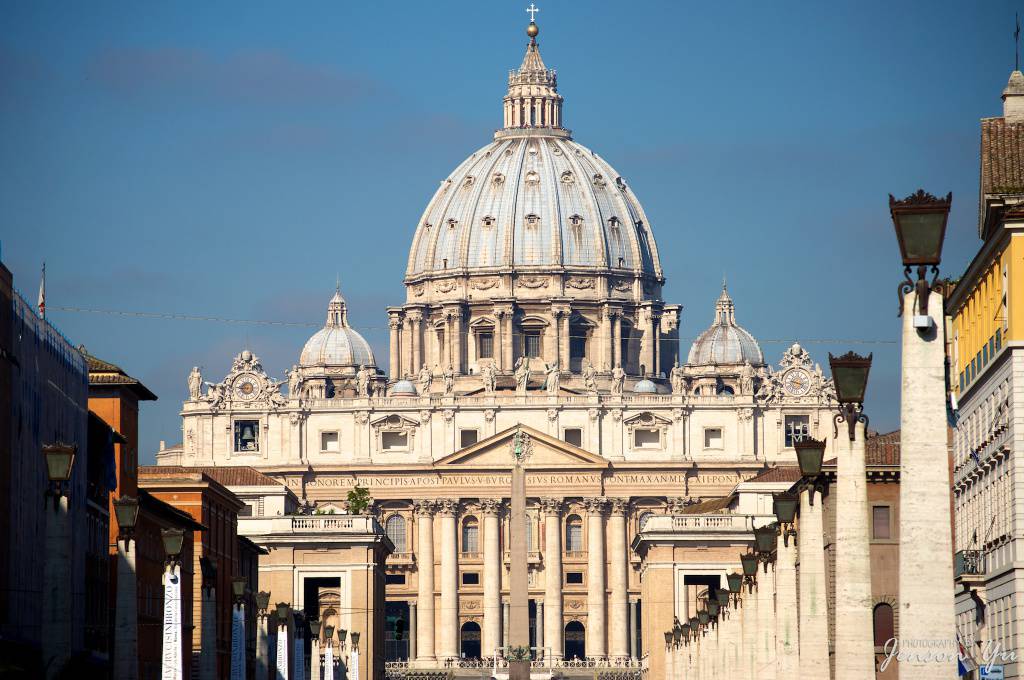 Toward the end of the 1400's it was decided that St. Peter's Basilica which had been built by Emperor Constantine in the 4th century should be replaced because it was so old and falling apart. Pope Julius II began the process of replacing the Basilica in 1506 and it took 126 years to complete the task which created the beautiful church we can visit today. That time period was a period of great tumultuousness in which great minds and great artists and great political moments all came together. The building of the Basilica was truly one of the biggest pieces of navel gazing that the Church could have engaged in. She was building the biggest church in the world to show how grand She was (at least that is what her leaders were thinking). Within 10 years of the start of the building the Church was strapped with enormous debts which needed to be met so that the work could go onward. A creative idea was born: the sale of indulgences for the salvation of relatives. It worked like this: someone working for the Church of Rome would come into a town and sell these pieces of paper in exchange for some money the relative's name would be written on it. These papers referred to the keys of Peter, that he was given the keys to open or lock the doors of heaven. The current Pope was using those keys to open the door of heaven for your beloved deceased.
Toward the end of the 1400's it was decided that St. Peter's Basilica which had been built by Emperor Constantine in the 4th century should be replaced because it was so old and falling apart. Pope Julius II began the process of replacing the Basilica in 1506 and it took 126 years to complete the task which created the beautiful church we can visit today. That time period was a period of great tumultuousness in which great minds and great artists and great political moments all came together. The building of the Basilica was truly one of the biggest pieces of navel gazing that the Church could have engaged in. She was building the biggest church in the world to show how grand She was (at least that is what her leaders were thinking). Within 10 years of the start of the building the Church was strapped with enormous debts which needed to be met so that the work could go onward. A creative idea was born: the sale of indulgences for the salvation of relatives. It worked like this: someone working for the Church of Rome would come into a town and sell these pieces of paper in exchange for some money the relative's name would be written on it. These papers referred to the keys of Peter, that he was given the keys to open or lock the doors of heaven. The current Pope was using those keys to open the door of heaven for your beloved deceased.
This practice was both popular and yet scandalous. Popular because now you could be sure that your loved one was in heaven; scandalous because it seemed too good to be true, plus there was no way of being assured that the person really did get admitted into heaven. You just had to trust the Pope and his sales staff. After Martin Luther purchased some of these for family members he began to doubt and the more he doubted the more he found other practices within the Church to be deficient. This led him to post his 95 Theses on the door of the Wittenberg Castle church in 1517. This began the Protestant Reformation. In 1521 at the Diet of Worms Martin Luther was publicly excommunicated for not refuting his Theses. This should have meant exile for Martin, but Friedrich the Elector stood beside him and supported him. The Church attempted to use any and all power that it might have to suppress the affront to it's dignity and sovereignty. Instead of finding a way to reunite a broken community all that power served to do was to splinter the Christian world into may little pieces, which even today continue to splinter.
It did not take too long before the protestors (Protestants) drew condemnation from the Church and they in turn condemned the Church. The stalemate of religious hatred lasted over 400 years, and many of us (a little older) have experienced the taste of those times. At the beginning of the 1960's Pope John XIII called together a Church Council to look at who we are as a Church, where and and who we wanted to be. One of the documents it produced was the Dogmatic Constitution on the Church (Lumen Gentium) in which it defines who exactly the Church is within herself and in relationship with others. In paragraph 15-16 the Council Fathers explore the Church's relationship with Protestants, Jews, Muslims and in fact all the rest of humanity. There is a remarkable passage: "These Christians are indeed in some real way joined to us in the Holy Spirit for, by his gifts and graces, his sanctifying power is also active in them and he has strengthened some of them even to the shedding of their blood. And so the Spirit stirs up desires and actions in all of Christ's disciples in order that all may be peaceable united, as Christ ordained."
With Pope Francis what we are witnessing in his inter-religious dialogue is a real healing of centuries old hatred and an attempt to bring us together with our strengths as the Council Fathers visioned several decades ago. There are always those who have grown comfortable living in the errors that have been brought about through many circumstances, but what Francis is showing that the way of the cross and the casting out of power is the real way of bringing about Christian Unity.

Comments
There are no comments yet - be the first one to comment: